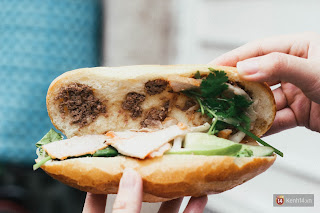BANH MI SAIGON – BANH MI KEP
Stuffed Bread
1/The history of banh mi Saigon
Banh mi is a Vietnamese term for all kinds of bread. The word is derived from Banh and Mi ( means " Wheat"). Bread, or more precisely, the baguette, was introduced by the French during its colonial period in Vietnam. Nowadays, the term "banh mi" also refers to the Vietnamese sandwich, which is a combination of deli-style pork, pate, and veggies stuffed into a soft and crunchy baguette.
Before, under the French colonialism, people often put butter and pate inside the baguette. Then when Vietnamese sent the French back to their country in 1954, they added some more ingredients such as sliced pork, herbs, and pickled vegetables and created the "banh mi" or Vietnamese sandwich as we know it now. Depending on the "fillings" ( what we fill inside the banh mi), we will have a different name for "Banh mi" such as " banh mi that" ( banh mi filled with sliced pork) or "banh mi pate ( banh mi filled with pate"). So the formula for the name of banh mi could go like this: banh mi + the main filling. It's very simple and easy.
Needless to say ( không cần phải nói), Banh mi is the most common food in Vietnam. People have it for their breakfast, lunch or even dinner. It's very cheap but super delicious. With 10.000 VND now you can have a perfect banh mi to ease your hunger.
2/ The ingredient of banh mi Saigon
The ingredients inside of Banh Mi Sai Gon depending on the region usually consists of 3 groups:
Animal meat: Vietnam-style sausage, chicken, cheese, fried eggs, rolls, ham, packaging, butter, onion, etc.
Vegetables: sliced cucumber, pickle, etc.
Sauces: soy sauce, fish sauce, soy sauce, pepper, sauce, soup, chili, etc.
3/ Some kinds of Banh Mi Sai Gon
The classic version, bánh mì thịt nguội, sometimes known as bánh mì đặc biệt or "special combo," is made with various Vietnamese cold cuts, such as sliced pork or pork bellies, chả lụa (pork sausage), and head cheese, along with the liver pâté and vegetables.
Some restaurants also offer bánh mì chay, a vegetarian option, made with tofu or seitan. In Vietnam, vegetarian sandwiches are rarely found on the streets. They are usually made at Buddhist temples during special religious events.
Another option is" bánh mì trứng," with scrambled eggs served in a baguette. The version eaten more widely for breakfast in Vietnam is eggs fried sunny-side-up ("bánh mì ốp la") with onions, sprinkled with soy sauce or Maggi sauce, served on a fresh (and sometimes buttered) baguette.
4/ The review of Banh Mi Sai Gon
Banh mi Sai Gon was brought to America in popularity. A very interesting study of the specialist food science department at the University of Leeds (UK), the "meat texture and crispness when the bit is more interesting than the flavors of the meat in banh mi.
A neighboring people, he Wei Chan also love their bread Vietnam, he has studied for many years to get the secrets of the banh mi and opened a store in Singapore. He said, his shop every day to sell more than one hundred banh mi Vietnam. Surprisingly that he enjoys this dish is not from Vietnam, he enjoys this banh mi in Canada while he studied aboard.
March 2011, the Banh MI, to indicate burger meat from Vietnam, were present in the Oxford dictionary. The report recognized that sandwiches Vietnam is one of the street food the world's finest.








































